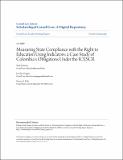|
Reseña:
|
The right to education is often referred to as a “multiplier right” because its enjoyment enhances other human rights. It is enumerated in several international instruments, but it is codified in greatest detail in the International Covenant on Economic, Social and Cultural Rights (ICESCR). Despite its importance, the right to education has received limited attention from scholars, practitioners, and international and regional human rights bodies as compared to other economic, social and cultural rights (ECSRs). In this Article, we propose a methodology that utilizes indicators to measure treaty compliance with the right to education. Indicators are essential to measuring compliance with ECSRs because indicators are, in many cases, the only way to evaluate whether or not a State is progressively realizing its obligations to fulfill ESCRs. Human rights scholars, professionals and intergovernmental organizations have been increasingly interested in using indicators to measure and enforce a State’s compliance with its obligations under international human rights treaties. However, there have been few attempts to develop a comprehensive methodology that uses human rights indicators closely tied to treaty language to measure a State’s compliance with the right to education. Furthermore, there are no studies of which we are aware that analyze a specific country’s treaty compliance using indicators. This Article’s proposed framework is used to evaluate Colombia’s compliance with its obligations relating to the right to education under the ICESCR.In particular, the methodology that we propose to develop a suitable framework for measuring State party fulfillment of the right to education under the ICESCR calls for: 1) analyzing the specific language of the ICESCR that pertains to ensuring the right; 2) defining the concept and scope of obligations of the right in order to identify indicators for measurement; 3) identifying appropriate indicators to measure State compliance; 4) setting benchmarks to measure progressive realization; and 5) clearly identifying what constitutes a violation of the right to education in order to improve future State party compliance with its obligations under the ICESCR. This methodology can be used by States in reports and by NGOs in shadow reports submitted to the Committee on Economic, Social and Cultural Rights (CESCR), the committee that monitors compliance with the ICESCR. From our case study of Colombia, we conclude that, although Colombia has made strides in improving educational access, it is not in compliance with its many of its obligations relating to the right to education under the ICESCR. |

